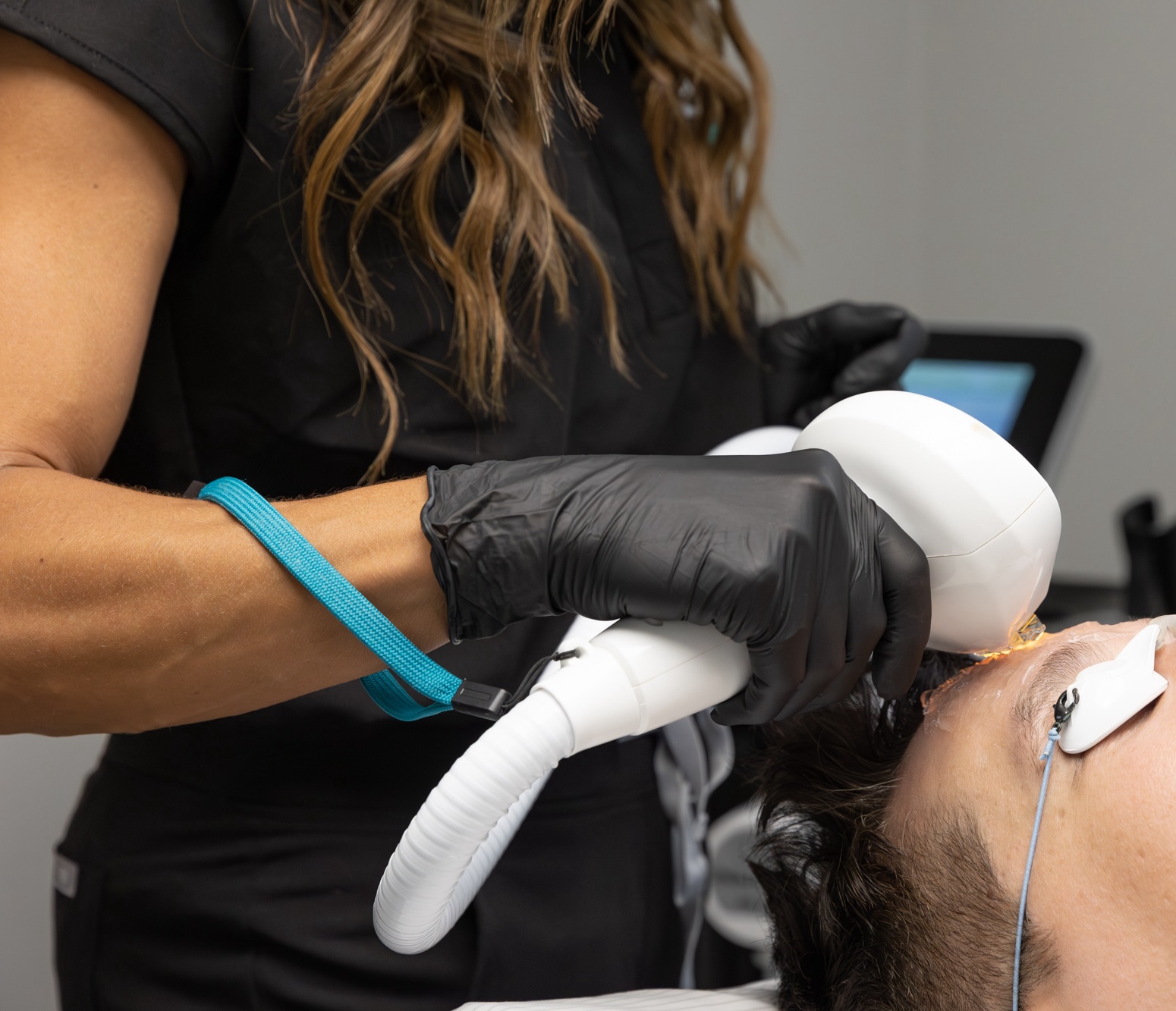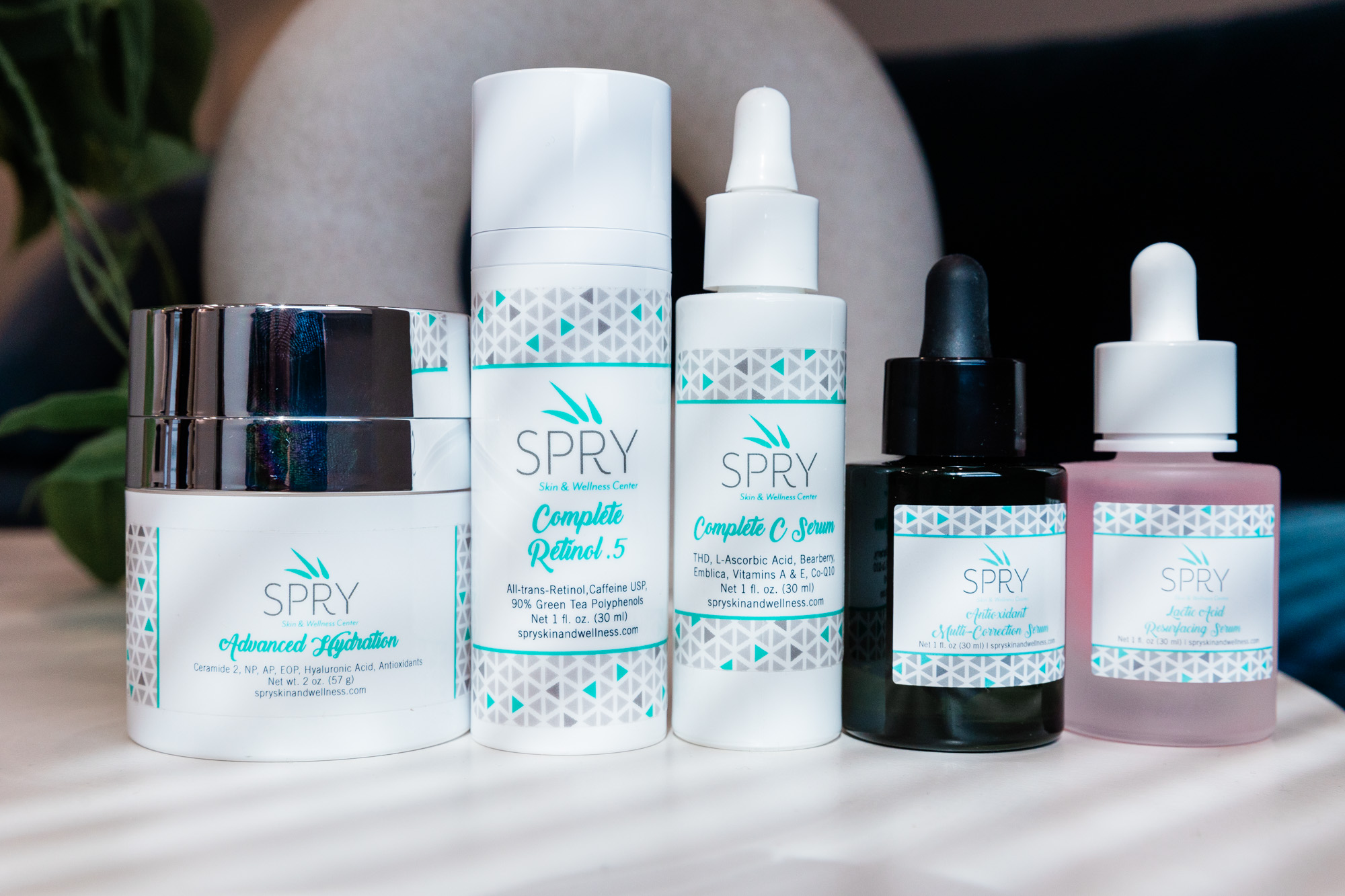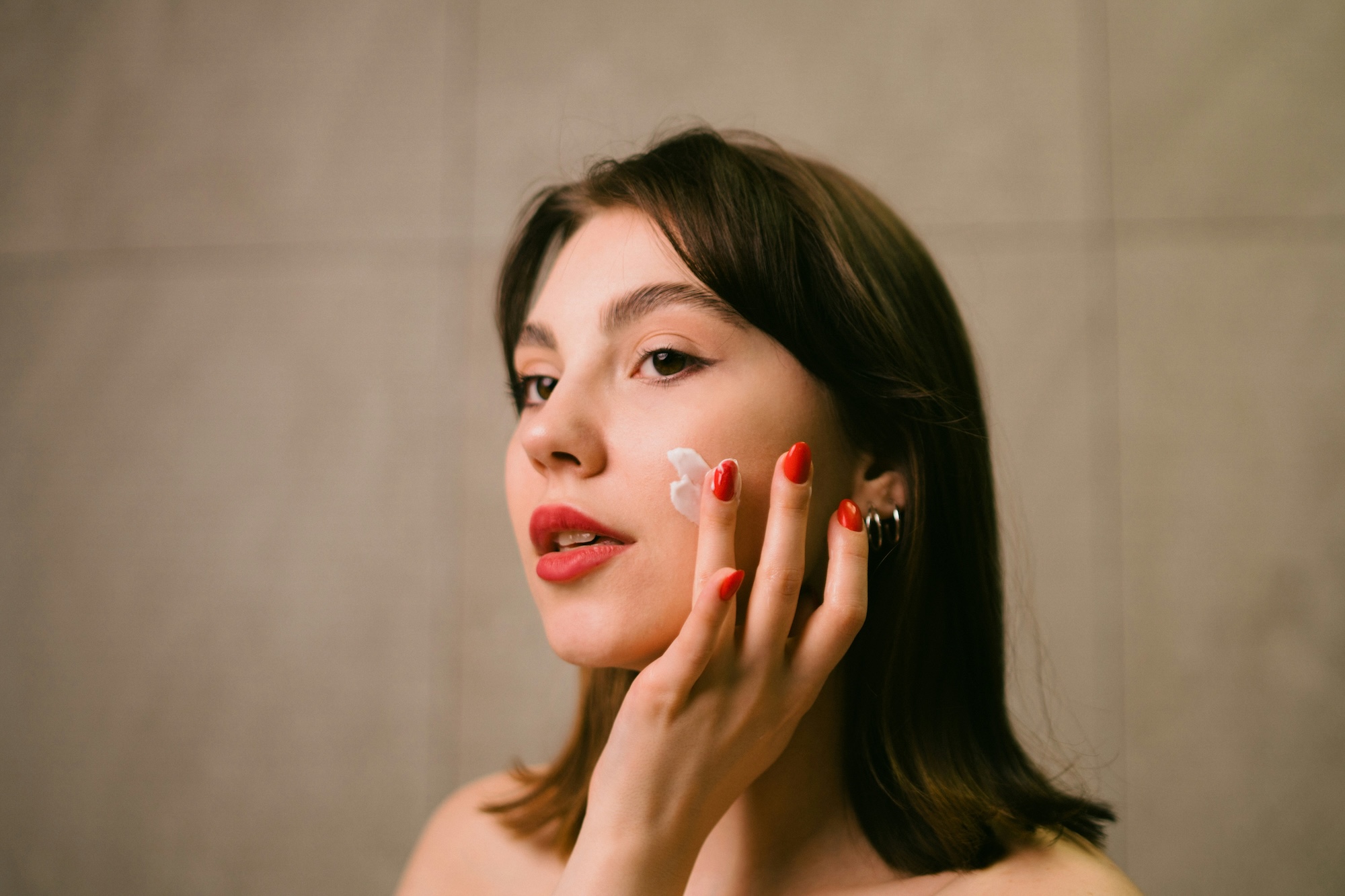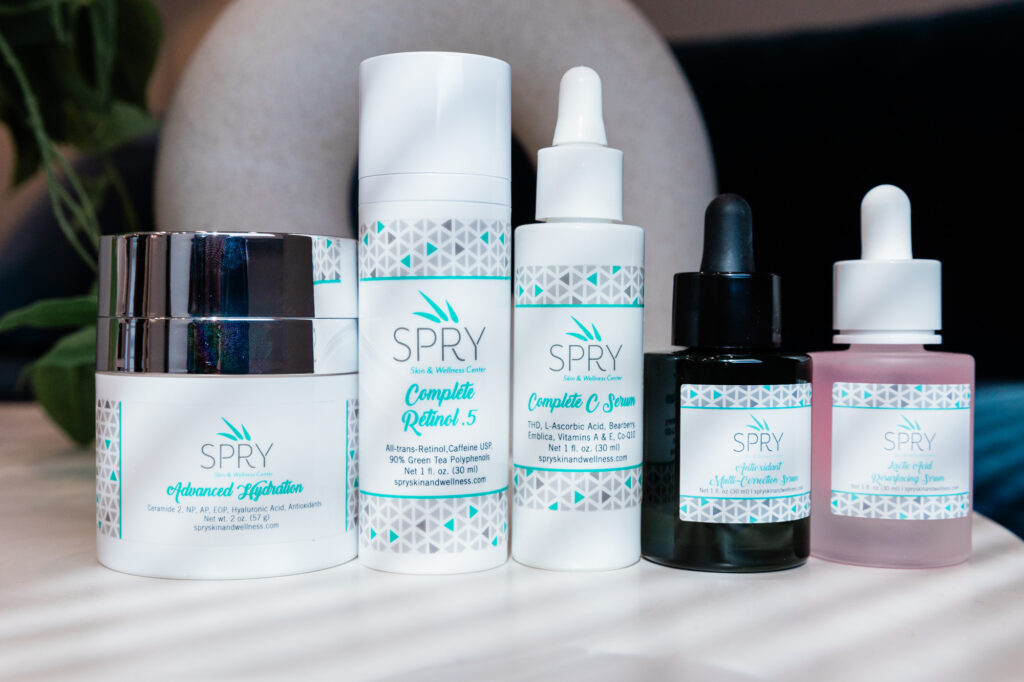
At SPRY Skin & Wellness, we are dedicated to using state-of-the-art treatments to address a variety of skin concerns. Our experts use their in-depth knowledge and experience to correct common issues like wrinkles, fine lines, scarring, and more. But one of the most common issues that we help improve is hyperpigmentation.
Here we’ll describe everything you need to know about hyperpigmentation, including what causes it, the types of hyperpigmentation, and your options for hyperpigmentation treatment in Waterloo.
What is hyperpigmentation?
Hyperpigmentation is a common condition that makes patches of your skin have a lighter or darker tone. While they are not necessarily painful or uncomfortable, they can oftentimes make people feel less confident in their complexion. The areas of skin can be brown, black, gray, red or pink, and while they may not necessarily indicate a serious health issue, it does reveal to our providers that those areas of your skin have experienced some kind of damage.
One reason you may not be familiar with the idea of hyperpigmentation is because there are different forms of hyperpigmentation. The most common types of hyperpigmentation include the following.
Sun Spots & Age Spots
While some believe sun spots and age spots are different, at SPRY, we prefer to characterize them together because they look the same and have very similar causes.
They appear in the form of small circles that appear on your skin that are tan, pink, or brown. Regular exposure to direct sunlight without sunscreen is what causes sun spots, and they can become more prevalent as you age.
When your skin is exposed to ultraviolet light, it produces more melanin as a protection response, which makes your skin appear darker.
For some, this means your skin tans evenly. For others with more delicate skin, the melanin bands together to form “spots.” While anyone can develop sun spots, they are most common in those with fair or light skin. However, we can easily address these issues with our options for hyperpigmentation treatment in Waterloo.
Melasma
Melasma is another common condition that appears in patches of dark brown, black, or blue/gray pigmentation appearing on your skin. While harmless, it can impact a person’s confidence since these large dark patches can appear anywhere on your face.
Melasma is a chronic condition mostly appearing in women, and commonly appears during pregnancy. While physicians do not know the exact reason, many think that the changing levels of hormones in a woman’s body influences the development of melasma.
There are many causes of melasma, including:
- Antiseizure medications
- Certain makeup and skincare products
- Consistent exposure to LED screens
- Contraceptive therapy
- Hormones
- Hyperthyroidism
- Man-made forms of estrogen
- Phototoxic drugs
- Radiation from ultraviolet light, visible light, or infrared light
- Tanning beds
While we cannot cure melasma, we can use our hyperpigmentation treatment in Waterloo to help treat it and reduce the amount of pigmentation present in your skin.
Post-Inflammatory Hyperpigmentation
Post-inflammatory hyperpigmentation is when your skin becomes darker or more pigmented after experiencing an injury or inflammation. Melanin production increases in these areas of the skin, which then causes hyperpigmentation. The common conditions that cause post-inflammatory hyperpigmentation include:
- Acne
- Eczema
- Atopic dermatitis
- Psoriasis
- Wounds (cuts, burns, scrapes)
- Allergic reactions
This type of hyperpigmentation is more common in those with darker skin, and while it can resolve itself, this could take months or even years to do so. Thankfully, we offer a variety of options at SPRY for hyperpigmentation treatment in Waterloo.
(Sometimes) Freckles
Sometimes, patients consider freckles as a type of hyperpigmentation. While they become darker after exposing your skin to direct sunlight, genetics is actually the main cause of freckles. Every patient has a different preference when it comes to how prominent they want their freckles to appear. And as these beauty trends continue to change over time, it may be the case that a patient may want some or all of them removed. However, these beauty trends tend to change and sometimes, patients consider freckles a beauty bonus rather than a detriment.

How to Get Rid of Hyperpigmentation
Here are the options we provide at SPRY when it comes to hyperpigmentation treatment in Waterloo.
Chemical Peels
The VI peel is an excellent way to treat hyperpigmentation. It is a medium-depth chemical peel that uses a mixture of salicylic acid, trichloroacetic acid (TCA), and phenol to peel away damaged skin cells and reveal more evenly toned and refreshed skin.
This mixture causes a reaction within your skin and encourages dead or damaged skin cells to flake off and peel away, effectively removing the damaged skin that contains the concentrated amounts of pigment. This process causes your skin to believe it has been injured, so it stimulates your natural healing response to increase collagen and elastin production.
Collagen and elastin are the two proteins that keep our skin flexible, smooth, and healthy. With additional levels of these proteins within your skin, your body can rebuild healthier, smoother, and more even-toned skin.
PRX
Unlike a chemical peel, the PRX treatment promotes a clearer complexion by creating a micro-inflammatory response within the epidermis, or the uppermost layer of the skin. It does so by combining TCA, Kojic acid, and hydrogen peroxide, which stimulate your body’s natural healing response.
With about 4 sessions of this hyperpigmentation treatment in Waterloo, you can speed up your skin’s natural cellular turnover process, causing it to remove pigmented skin cells faster than normal. It will then replace them with healthier, non-pigmented skin cells to create a more even skin tone.
IPL Photofacial
The IPL photofacial is less invasive than other treatments, but it was specifically designed to target unwanted pigment in the skin. This treatment converts wide-spectrum light into heat, causing damage to the superficial blood vessels and pigment, destroying them and removing them from your skin.
Like the other options for hyperpigmentation treatment in Waterloo, this process increases your body’s natural production of collagen and elastin, which helps repair any cellular damage within your skin. By doing so, this improves your skin’s ability to heal, retain moisture, and much more, enhancing the health and appearance of your body’s largest organ.

Why Skincare is Important
No matter which treatment you receive for hyperpigmentation, your provider will emphasize following an at-home skincare routine. While all of these in-office treatments help kick off the process of shedding away hyperpigmentation, it will take continuous effort every day to see the results you are looking for—and maintain them. Our providers can curate specific product recommendations during your individual consultation. That said, here is a general roadmap you can follow at home to maintain your clear skin tone over time.
Morning Routine
1) Cleanser
Cleanser helps to remove dead skin cells, dried sweat, and other debris that your skin produced while you were sleeping. We typically recommend a foaming cleanser since they are more gentle on the skin, but talking with your provider about a condition-specific cleanser would be ideal.
2) Serums
Serums like niacinamide, Vitamin C, and hyaluronic acid help customize your skincare regimen by addressing specific concerns like hyperpigmentation. Be sure to look for specific active ingredients to help with cellular turnover and maintaining collagen and elastin production. Note that certain actives do not interact well with one another, so we will recommend specifically what actives to pair together to avoid causing any negative reactions.
3) Moisturizer
After applying your specific serums, applying moisturizer will lock in their effects. Moisturizer helps regulate your skin’s natural production of oil, or sebum. It also helps your skin retain moisture, so you can have a consistent, refreshed, glowing complexion that only comes from having healthy and well-cared-for skin.
4) Sunscreen
The very last part of your morning routine is the most important because it protects your skin from sustaining damage throughout the day, and that step is sunscreen. While your provider can talk to you about what types of sunscreen and SPF level would work best for your skin type, we typically recommend using a mineral-based sunscreen with a minimum SPF of 30. Then, we recommend reapplying it every 2 to 3 hours, as sunscreen does wear off throughout the day.
Evening Routine
1) Cleanser
The first step of your evening routine will be a cleanser to fully remove any makeup, surface-level debris, and/or built up oil that your skin collected throughout the day. You can use the same cleanser as you use in your morning routine, but we recommend using a hydrating cleanser to aid in overnight moisturizer.
2) Exfoliator
Exfoliating products reach deep into your pores to remove dried oil and dead skin cells. Exfoliators also increase your body’s production of collagen and elastin and boost cellular turnover, helping improve your skin while you sleep at night. Note that there are two types of exfoliation products: chemical and manual. Depending on your skin type, skin tone, and overall concerns, one might be better than the other. Some of our patients also incorporate both, alternating between chemical exfoliation 1 to 2 times per week and a daily manual exfoliation powder/scrub every other night.
3) Serums
Certain serums may benefit your skin, but they may not react well with other products in your morning routine. Your evening routine is a great opportunity to use those other serums that do not fit into your morning routine. It’s also a great time to use any serums that might cause some redness or sensitivity to sunlight, such as retinol, to take advantage of their benefits without risking unwanted side effects during the daytime.
4) Moisturizer
You should finish off your evening routine with a moisturizer or face mask that will maintain your skin’s hydration overnight and lock in the effects of your serums. This will help you wake up with a refreshed, glowing look the next morning. We recommend using a different, lighter moisturizer at night than during the day, as too heavy of a product can cause excess oil production and/or breakouts by morning.

Say Hello to Clear, Even-Toned Skin
Hyperpigmentation shouldn’t keep you from loving your skin. To find the right hyperpigmentation treatment in Waterloo, you can either request an appointment with one of our skin experts, or use our complimentary treatment planning tool to begin exploring the best options based on your needs.
Request a Skin Assessment Build My Treatment Plan




